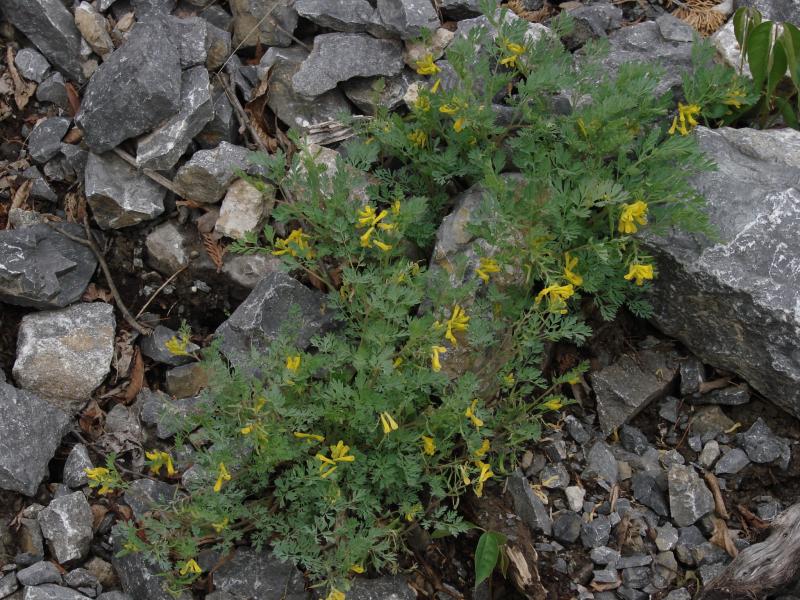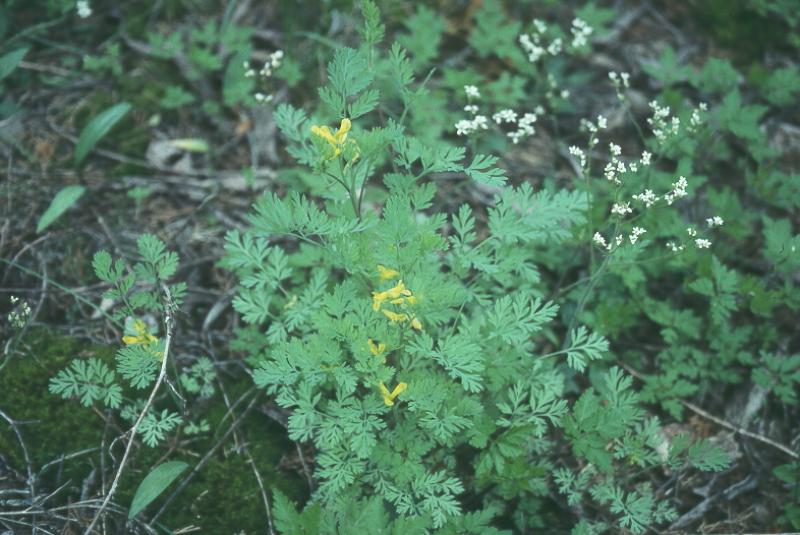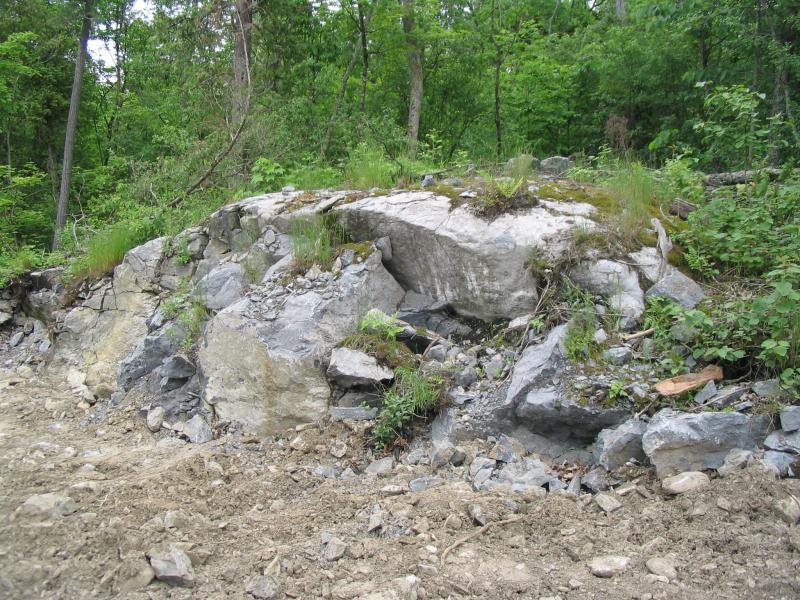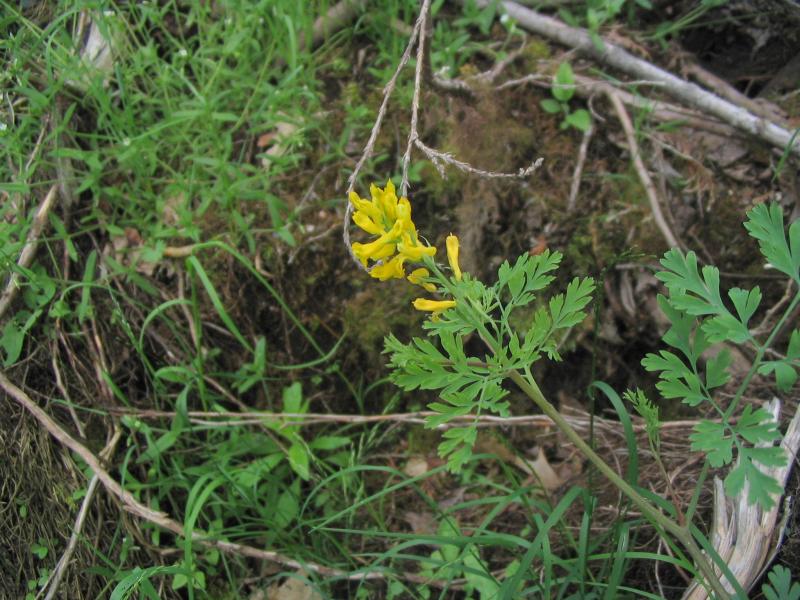Golden Corydalis
Corydalis aurea Willd.
- Class
- Dicotyledoneae (Dicots)
- Family
- Papaveraceae (Poppy Family)
- State Protection
- Threatened
Listed as Threatened by New York State: likely to become Endangered in the foreseeable future. For animals, taking, importation, transportation, or possession is prohibited, except under license or permit. For plants, removal or damage without the consent of the landowner is prohibited.
- Federal Protection
- Not Listed
- State Conservation Status Rank
- S2
Imperiled in New York - Very vulnerable to disappearing from New York due to rarity or other factors; typically 6 to 20 populations or locations in New York, very few individuals, very restricted range, few remaining acres (or miles of stream), and/or steep declines.
- Global Conservation Status Rank
- G5
Secure globally - Common in the world; widespread and abundant (but may be rare in some parts of its range).
Summary
Did you know?
The seeds of golden corydalis have a nutrient-rich appendage, or aril, typically found in plant wildflower species attractive to ants. The ants collect the arils, which in turn serves to disperse the seeds. The corms of Corydalis and related plants contain alkaloids used in traditional Native American and Chinese medicines.
State Ranking Justification
In New York there are 9 verified, current locations for golden corydalis; 3 of these occurrences are very small. There are about 10 historical locations need to be checked.
Short-term Trends
The transitory nature of this species, which may appear for only a few years following a disturbance but persist in the seed bank and re-appear when conditions are favorable, make it difficult to track at any given location.
Long-term Trends
More inventory of historical locations is needed in order to better assess long-term trends for New York populations of this species.
Conservation and Management
Threats
Changes in disturbance regime (both natural and human disturbance) could threaten occurrences of this species.
Conservation Strategies and Management Practices
Regular disturbance may be needed for populations of golden corydalis to persist over time.
Research Needs
Additional inventory of historical sites, as well as monitoring of extant sites as conditions change, is needed.
Habitat
Habitat
In New York golden corydalis is known primarily from dry, rocky calcareous sites, including alvar and limestone pavements, barrens, summits, and woodlands (New York Natural heritage program 2007). In other states it also occurs on gravelly shores, rock ledges and summits, piney woodlands, and disturbed sites such as clearings, trails, and gravel or sand pits (Voss 1985, Rhoads and Block 2000).
Associated Ecological Communities
- Alvar pavement grassland
(guide)
This community consists of exposed, flat limestone or dolostone pavement with grassy or mossy patches interspersed throughout. Some examples may be solely grassland with no pavement.
- Alvar shrubland*
(guide)
A shrub-dominated community that has over 25% cover of tall, short, and dwarf shrubs. There are often deep crevices or grikes in the limestone pavement; trees and shrubs are often rooted in the grikes.
- Alvar woodland
(guide)
A subset of the limestone woodland community restricted to the alvar region in Jefferson County, New York.
- Calcareous cliff community*
(guide)
A community that occurs on vertical exposures of resistant, calcareous bedrock (such as limestone or dolomite) or consolidated material; these cliffs often include ledges and small areas of talus.
- Calcareous red cedar barrens*
(guide)
A small-patch calcareous rocky summit community occurring on dry, south-facing to southwest-facing slopes and low summits. These sites are characterized by stunted, sparse woodlands with small grassland openings.
- Calcareous shoreline outcrop
(guide)
A community that occurs along the shores of lakes and streams on outcrops of calcareous rocks such as limestone and dolomite. The vegetation is sparse; most plants are rooted in rock crevices.
- Calcareous talus slope woodland*
(guide)
An open or closed canopy community that occurs on talus slopes composed of calcareous bedrock such as limestone or dolomite. The soils are usually moist and loamy; there may be numerous rock outcrops.
- Cliff community*
(guide)
A community that occurs on vertical exposures of resistant, non-calcareous bedrock (such as quartzite, sandstone, or schist) or consolidated material; these cliffs often include ledges and small areas of talus.
- Dwarf pine ridges*
(guide)
A woodland community dominated by dwarf individuals of pitch pine and black huckleberry, which occurs on flat-topped summits of rocky ridges. The bedrock is a white quartzite conglomerate; soils are very thin, and they are rich in organic matter from litter that has accumulated on the bedrock.
- Great Lakes bluff*
(guide)
A sparsely vegetated community that occurs on vertical exposures of unconsolidated material, such as small stone, gravel, sand, and clay, that is exposed to Great Lakes erosional forces, such as water, ice, or wind.
- Limestone woodland
(guide)
A woodland that occurs on shallow soils over limestone bedrock in non-alvar settings, and usually includes numerous rock outcrops. There are usually several codominant trees, although one species may become dominant in any one stand.
- Northern white cedar rocky summit*
(guide)
A community that occurs on cool, dry, rocky ridgetops and summits where the bedrock is calcareous (such as limestone or dolomite), and the soils are more or less calcareous. The vegetation may be sparse or patchy, with numerous rock outcrops. The species have predominantly boreal distributions.
- Pitch pine-oak-heath rocky summit*
(guide)
A community that occurs on warm, dry, rocky ridgetops and summits where the bedrock is non-calcareous (such as quartzite, sandstone, or schist), and the soils are more or less acidic. This community is broadly defined and includes examples that may lack pines and are dominated by scrub oak and/or heath shrubs apparently related to fire regime.
- Red cedar rocky summit*
(guide)
A community that occurs on warm, dry, rocky ridgetops and summits where the bedrock is calcareous (such as limestone or dolomite, but also marble, amphibolite, and calcsilicate rock), and the soils are more or less calcareous. The vegetation may be sparse or patchy, with numerous lichen covered rock outcrops.
- Roadcut cliff/slope*
A sparsely vegetated cliff or steep slope, along a road, that was created by blasting or digging during road construction.
- Rock quarry*
An excavation in bedrock from which building stone (e.g., limestone, sandstone, slate) has been removed. Vegetation may be sparse; plants may be rooted in crevices in the rock surface.
- Shale cliff and talus community*
(guide)
A community that occurs on nearly vertical exposures of shale bedrock and includes ledges and small areas of talus. Talus areas are composed of small fragments that are unstable and steeply sloping; the unstable nature of the shale results in uneven slopes and many rock crevices.
- Successional red cedar woodland*
A woodland community that commonly occurs on abandoned agricultural fields and pastures, usually at elevations less than 1000 ft (305 m). The dominant tree is eastern red cedar, which may occur widely spaced in young stands and may be rather dense in more mature stands.
* probable association but not confirmed.
Associated Species
- Adiantum pedatum (maidenhair fern)
- Adlumia fungosa (Allegheny-vine)
- Campanula rotundifolia (hare-bell)
- Carex backii (Back's sedge)
- Carex deweyana
- Carex eburnea (bristle-leaved sedge)
- Carex rosea (common upland star sedge)
- Cynoglossum virginianum
- Dryopteris marginalis (marginal wood fern)
- Fragaria virginiana
- Geranium bicknellii (northern crane's-bill)
- Juniperus virginiana
- Ostrya virginiana (hop hornbeam, ironwood)
- Pinus strobus (white pine)
- Poa compressa (flat-stemmed blue grass, Canada blue grass)
- Quercus rubra (northern red oak)
- Saxifraga virginiensis
- Thuja occidentalis (northern white cedar, arbor vitae)
- Tilia americana
- Toxicodendron radicans
Range
New York State Distribution
There are scattered locations in eastern New York from Canada to Long Island, as well as sites in Jefferson and Tompkins counties further west.
Identification Comments
Best Life Stage for Proper Identification
Golden corydalis is best identified when in flower.
Similar Species
Corydalis flavula, the only other yellow-flowered corydalis in New York, has similar leaves but its flowers are about half the size of those of C. aurea, and have a prominent crest or wing on the outer petal not found in golden corydalis. Corydalis flavula also is typically found in wetter and/or less open sites than C. aurea.
Golden corydalis may grow alongside Corydalis sempervirens (Rock Harlequin, or Pale Corydalis), which has pink to purplish flowers. In vegetative form C. aurea differs from C. sempervirens by its less glacous leaves and stems, more sprawling habit, and more finely dissected leaves.
Best Time to See
Golden corydalis may be found flowering from May into September; fresh flowers found in late summer may be the product of fruit from early-blooming plants of the same season. The leaves senesce but persist into flowering and fruiting. Flowering specimens are best for identification and collection purposes.
- Flowering
- Fruiting
The time of year you would expect to find Golden Corydalis flowering and fruiting in New York.
Golden Corydalis Images
Taxonomy
Golden Corydalis
Corydalis aurea Willd.
- Kingdom Plantae
- Phylum Anthophyta
- Class Dicotyledoneae
(Dicots)
- Order Papaverales
- Family Papaveraceae (Poppy Family)
- Order Papaverales
- Class Dicotyledoneae
(Dicots)
- Phylum Anthophyta
Synonyms
- Capnoides aureum (Willd.) Kuntze
Additional Resources
Best Identification Reference
Gleason, Henry A. and A. Cronquist. 1991. Manual of Vascular Plants of Northeastern United States and Adjacent Canada. The New York Botanical Garden, Bronx, New York. 910 pp.
Other References
Holmgren, Noel. 1998. The Illustrated Companion to Gleason and Cronquist's Manual. Illustrations of the Vascular Plants of Northeastern United States and Adjacent Canada. The New York Botanical Garden, Bronx, New York.
House, Homer D. 1924. Annotated list of the ferns and flowering plants of New York State. New York State Museum Bulletin 254:1-758.
Mitchell, R. S. 1983. Berberodaceae through Fumariaceae of New York State. New York State Museum Bull. 451: 1-66.
Mitchell, Richard S. and Gordon C. Tucker. 1997. Revised Checklist of New York State Plants. Contributions to a Flora of New York State. Checklist IV. Bulletin No. 490. New York State Museum. Albany, NY. 400 pp.
New York Natural Heritage Program. 2010. Biotics database. New York Natural Heritage Program. New York State Department of Environmental Conservation. Albany, NY.
New York Natural Heritage Program. 2024. New York Natural Heritage Program Databases. Albany, NY.
Rhoads, Ann F. and Timothy A. Block. 2000. The Plants of Pennsylvania, an Illustrated Manual. University of Pennsylvania Press, Philadelphia, PA.
Smith, Gerald A. No date. Bird breeding season survey at El Dorado Beach Preserve 1981-.
Voss, E.G. 1985. Michigan Flora. Part II. Dicots (Saururaceae - Cornaceae). Cranbrook Institute of Science and University of Michigan Herbarium. Ann Arbor, Michigan. 724 pp.
Weldy, T. and D. Werier. 2010. New York flora atlas. [S.M. Landry, K.N. Campbell, and L.D. Mabe (original application development), Florida Center for Community Design and Research http://www.fccdr.usf.edu/. University of South Florida http://www.usf.edu/]. New York Flora Association http://newyork.plantatlas.usf.edu/, Albany, New York
Links
About This Guide
Information for this guide was last updated on: January 5, 2009
Please cite this page as:
New York Natural Heritage Program. 2024.
Online Conservation Guide for
Corydalis aurea.
Available from: https://guides.nynhp.org/golden-corydalis/.
Accessed July 26, 2024.



